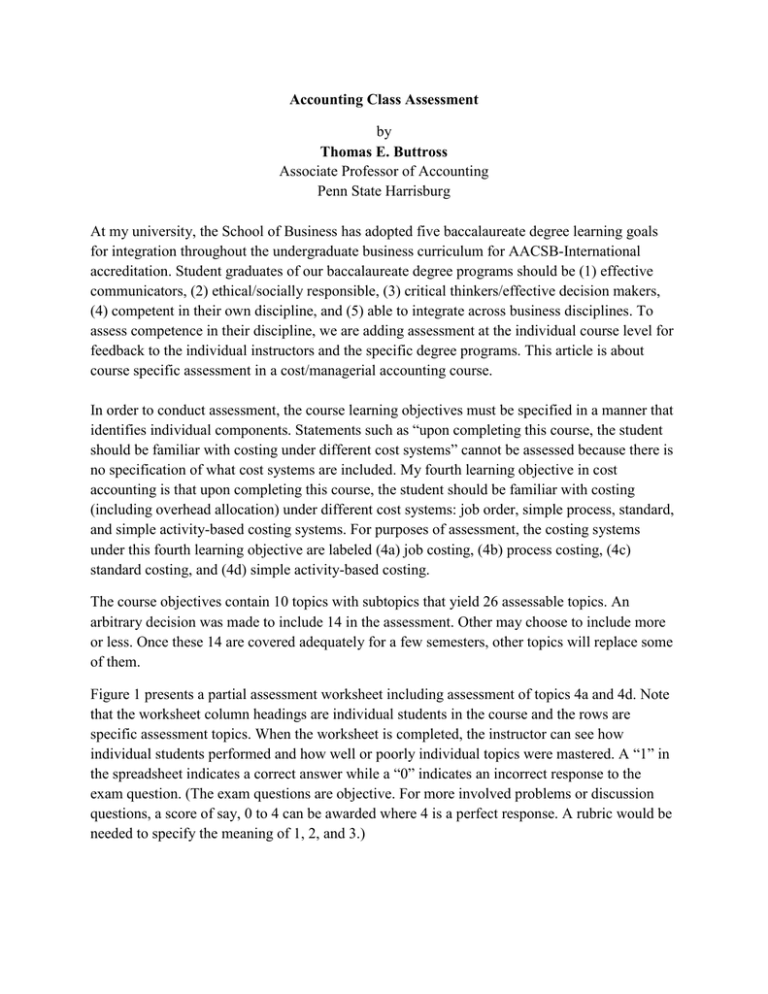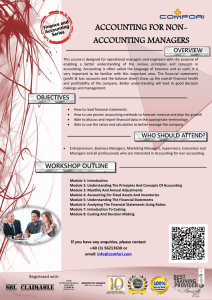Learning Outcomes Assessment Example from Accounting
advertisement

Accounting Class Assessment by Thomas E. Buttross Associate Professor of Accounting Penn State Harrisburg At my university, the School of Business has adopted five baccalaureate degree learning goals for integration throughout the undergraduate business curriculum for AACSB-International accreditation. Student graduates of our baccalaureate degree programs should be (1) effective communicators, (2) ethical/socially responsible, (3) critical thinkers/effective decision makers, (4) competent in their own discipline, and (5) able to integrate across business disciplines. To assess competence in their discipline, we are adding assessment at the individual course level for feedback to the individual instructors and the specific degree programs. This article is about course specific assessment in a cost/managerial accounting course. In order to conduct assessment, the course learning objectives must be specified in a manner that identifies individual components. Statements such as “upon completing this course, the student should be familiar with costing under different cost systems” cannot be assessed because there is no specification of what cost systems are included. My fourth learning objective in cost accounting is that upon completing this course, the student should be familiar with costing (including overhead allocation) under different cost systems: job order, simple process, standard, and simple activity-based costing systems. For purposes of assessment, the costing systems under this fourth learning objective are labeled (4a) job costing, (4b) process costing, (4c) standard costing, and (4d) simple activity-based costing. The course objectives contain 10 topics with subtopics that yield 26 assessable topics. An arbitrary decision was made to include 14 in the assessment. Other may choose to include more or less. Once these 14 are covered adequately for a few semesters, other topics will replace some of them. Figure 1 presents a partial assessment worksheet including assessment of topics 4a and 4d. Note that the worksheet column headings are individual students in the course and the rows are specific assessment topics. When the worksheet is completed, the instructor can see how individual students performed and how well or poorly individual topics were mastered. A “1” in the spreadsheet indicates a correct answer while a “0” indicates an incorrect response to the exam question. (The exam questions are objective. For more involved problems or discussion questions, a score of say, 0 to 4 can be awarded where 4 is a perfect response. A rubric would be needed to specify the meaning of 1, 2, and 3.) % Correct 0 0 x No. Correct 1 1 x Student 35 of 35 Student 2 4a 17 4d 19 14 topics total Student 1 Comprehensive Final Exam Question No. Assessment Topic Figure 1 Partial Assessment Worksheet Description of Assessment Topic 0.66 Job costing system 1 23 0 32 0.91 Activity-based costing system xx x No. Correct 10 7 11 495 10.8 % Correct 0.71 0.50 0.79 35 0.77 Pass 70% or Fail Pass Fail Pass Let’s first address students. An arbitrary decision was made that a student should master a minimum of 70% of the topics (10 of the 14 topics) in order to be labeled as a pass, and that at least 70% of the class should pass for the course to be considered successful in meeting its objectives. This percentage was selected because it represents a passing score for the course (C required and 70% is the minimum C) and because the course includes a closed-book comprehensive final examination. (For an open-book exam, take-home exam, or noncomprehensive exam, a higher percentage might be prudent.) In figure 1, student 1 and student 35 both passed, while student 2 failed to master enough concepts. (This pass/fail designation has nothing to do with the student’s course grade, which is based on the entire final exam, other exams, quizzes, and homework specified on the syllabus.) Assuming 27 of the 35 students are labeled pass, the course would have an overall pass rate of 77% (27/35) and would be considered successful. Now let’s address topics. On topic 4a job costing, 23 of the 35 responses were correct, yielding only 66%. This feedback indicates that the topic was not mastered at the desired level and attention needs to be directed at this during the next offering of the course. The activity-based costing topic was, on the other hand, well mastered. This feedback can also be used as feed forward to future courses, where appropriate. For example, a finding in principles of accounting that the time value of money was not mastered would alert the intermediate instructor to review this concept before covering bond pricing or lease discounting. Assessment is providing insights to the instructor and the degree programs that provide value beyond accreditation and this was the goal of assessment all along. Published in the online newsletter of the Teaching, Learning & Curriculum (TLC) Section of the American Accounting Association: The Accounting Educator, Vol. XVIII no. 2, http://aaahq.org/TeachCurr/newsletters/Winter2009.pdf




